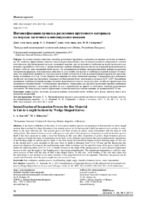Интенсификация процесса разделения пруткового материала на мерные заготовки клиновидными ножами

Date
2017Publisher
Another Title
Intensification of Separation Process for Bar Material in Cut-to-Length Sections by Wedge-Shaped Knives
Bibliographic entry
Исаевич, Л. А., Сидоренко М. И. Интенсификация процесса разделения пруткового материала на мерные заготовки клиновидными ножами = Intensification of Separation Process for Bar Material in Cut-to-Length Sections by Wedge-Shaped Knives / Л. А. Исаевич, М. И. Сидоренко // Наука и техника. – 2017. – № 1. - С. 16 - 20.
Abstract
На основе анализа известных способов разделения пруткового сортамента на мерные заготовки установлено, что наиболее эффективным является способ формообразования в нем кольцевой канавки клиновидного сечения пластическим деформированием металла дисковыми ножами, при постепенном углублении которой происходит разрушение сортамента в этой зоне. С целью снижения глубины канавки предложено после ее формообразования производить в этой же зоне локальный изгиб прутка. На основании полученных экспериментальных данных предложена эмпирическая формула, показывающая зависимость угла изгиба оси прутка от глубины кольцевой канавки. Установлено, что наибольшее влияние на угол локального изгиба оси прутка в зоне кольцевой канавки происходит при изменении ее глубины от 0,5 до 3,0 мм. Причем эта зависимость имеет степенной характер. Уменьшение угла локального изгиба оси заготовки для указанного интервала глубин канавки будет находиться в пределах 8,83º–2,23º. Дальнейшее увеличение глубины кольцевой канавки не имеет практического смысла, поскольку угол изгиба оси прутка при этом уменьшается несущественно. Установленная зависимость справедлива для процесса разделения прутков дисковыми клиновидными ножами с локальным изгибом их оси и практически не зависит от исходного диаметра разделяемого сортамента. Поэтому процесс может эффективно осуществляться при глубине канавки, не превышающей 3,0 мм.
Abstract in another language
It has been established on the basis of well-known method analysis on separation of bar materials in cut-to-length sections that a method for shape-formation of an annular groove in the bar material which has tapered cross-section is consi- dered as the most efficient one. The annular groove has been formed by plastic metal deformation with the help of disk cutting shears. Bar material fracture occurs in the groove zone when it has progressive deepening. In order to decrease groove depth it has been proposed to make a local bar bending in this zone after completion of groove shape-formation process. An empirical formula has been recommended on the basis of the obtained experimental data and it demonstrates dependence of bar bending angle on annular groove depth. It has been found that maximum impact on local bending angle of bar axis in the annular groove zone originates in the case when its depth is changing from 0.5 to 3.0 mm and the dependence has power-law character. Decrease in the local bending angle of the workpiece axis for specified range of the groove depth will be within the following limits: 8.83є to 2.23є. A further increase in the depth of the annular groove is out of practical importance because in this case the angle of bar bending axis is decreasing insignificantly. The determined dependence is valid for sepa-ration process of bars with the help of disk wedge-shaped knives. In this case local bending of the axis takes place and the dependence is not dictated by an initial diameter of bar material which is to be separated. Therefore, the process can be carried out efficiently when the groove depth does not exceed 3.0 mm.
View/
Collections
- №1[10]
